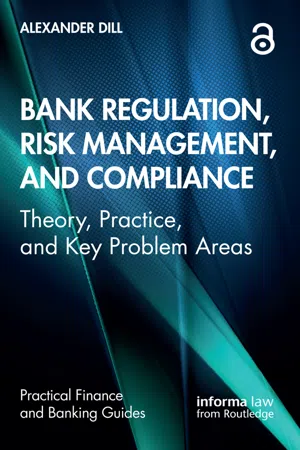
Bank Regulation, Risk Management, and Compliance
Theory, Practice, and Key Problem Areas
- 302 pages
- English
- ePUB (mobile friendly)
- Available on iOS & Android
Bank Regulation, Risk Management, and Compliance
Theory, Practice, and Key Problem Areas
About this book
Bank Regulation, Risk Management, and Compliance is a concise yet comprehensive treatment of the primary areas of US banking regulation – micro-prudential, macroprudential, financial consumer protection, and AML/CFT regulation – and their associated risk management and compliance systems. The book's focus is the US, but its prolific use of standards published by the Basel Committee on Banking Supervision and frequent comparisons with UK and EU versions of US regulation offer a broad perspective on global bank regulation and expectations for internal governance.
The book establishes a conceptual framework that helps readers to understand bank regulators' expectations for the risk management and compliance functions. Informed by the author's experience at a major credit rating agency in helping to design and implement a ratings compliance system, it explains how the banking business model, through credit extension and credit intermediation, creates the principal risks that regulation is designed to mitigate: credit, interest rate, market, and operational risk, and, more broadly, systemic risk. The book covers, in a single volume, the four areas of bank regulation and supervision and the associated regulatory expectations and firms' governance systems. Readers desiring to study the subject in a unified manner have needed to separately consult specialized treatments of their areas of interest, resulting in a fragmented grasp of the subject matter. Banking regulation has a cohesive unity due in large part to national authorities' agreement to follow global standards and to the homogenizing effects of the integrated global financial markets.
The book is designed for legal, risk, and compliance banking professionals; students in law, business, and other finance-related graduate programs; and finance professionals generally who want a reference book on bank regulation, risk management, and compliance. It can serve both as a primer for entry-level finance professionals and as a reference guide for seasoned risk and compliance officials, senior management, and regulators and other policymakers. Although the book's focus is bank regulation, its coverage of corporate governance, risk management, compliance, and management of conflicts of interest in financial institutions has broad application in other financial services sectors.
Chapter 6 of this book is freely available as a downloadable Open Access PDF at http://www.taylorfrancis.com under a Creative Commons Attribution-Non Commercial-No Derivatives (CC-BY-NC-ND) 4.0 license.
Frequently asked questions
- Essential is ideal for learners and professionals who enjoy exploring a wide range of subjects. Access the Essential Library with 800,000+ trusted titles and best-sellers across business, personal growth, and the humanities. Includes unlimited reading time and Standard Read Aloud voice.
- Complete: Perfect for advanced learners and researchers needing full, unrestricted access. Unlock 1.4M+ books across hundreds of subjects, including academic and specialized titles. The Complete Plan also includes advanced features like Premium Read Aloud and Research Assistant.
Please note we cannot support devices running on iOS 13 and Android 7 or earlier. Learn more about using the app.
Information
Part I
Foundations
Chapter 1
The banking business model and rise of the financial conglomerate
1.1 Introductory overview
1.2 Factors that cause banks to be so highly regulated
1.2.1 Intensity of regulation a function of banks’ central role in the economy
1.2.1.1 Banks’ role in the extension of credit
Table of contents
- Cover
- Half Title
- Series
- Title
- Copyright
- Dedication
- Contents
- List of figures
- List of tables
- List of abbreviations
- Table of legal sources
- Note about the author
- Acknowledgments
- Introduction
- Part I Foundations
- Part II Primary areas of bank regulation and internal governance
- References
- Index